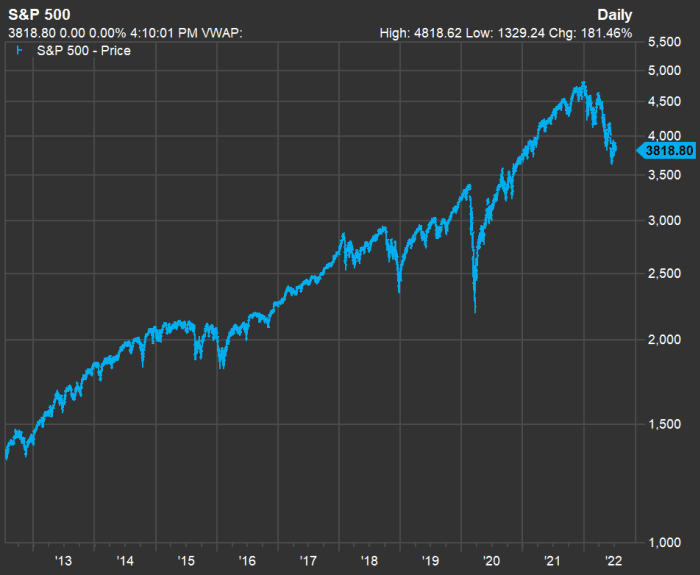#Deep Dive: These 7 beaten-down value stocks are a buy, says a money manager who has outperformed the S&P 500 for 30 years

Table of Contents
“Deep Dive: These 7 beaten-down value stocks are a buy, says a money manager who has outperformed the S&P 500 for 30 years”
The damage is already done, says John Buckingham of the Prudent Speculator, who argues it’s time to scoop up shares of Meta, Micron, Capital One and other companies
If you consider yourself to be a contrarian long-term investor, keeping things simple might be the best bet in this bear market for stocks.
The benchmark S&P 500 Index
SPX,
has fallen 20% this year, the worst start to a year in decades.
Buckingham has named seven value stocks to buy now, which he labeled “bargains thrown out with the bath water” in a recent report to clients. They are listed below.
The Prudent Speculator is published by Kovitz Investment Group of Chicago and remains at the top of the list for 30-year returns among newsletters tracked by the Hulbert Financial Digest. The TPS portfolio’s average annualized 30-year return is 14.5% through June 30, compared with 9.9% for the S&P 500, with dividends reinvested monthly, according to Hulbert.
During an interview, Buckingham explained the role of market psychology in investing: “You don’t want everyone to be euphoric. You want them to be down in the dumps.”
The idea is that there is nothing unusual about a 20% decline in stock prices. Broad market declines must be expected and even embraced for long-term success.
The Prudent Speculator’s portfolio includes 80 stocks identified as suitable for three- to five-year investments. Starting with about 3,000 publicly traded U.S. companies, Buckingham and his colleagues narrow the list to identify highly liquid, “potentially undervalued” names relative to the market.
One aspect of the value strategy is low prices relative to expected earnings. Buckingham said the TPS portfolio’s forward price-to-earnings (P/E) ratio was 10.4 as of July 12. In comparison, the forward P/E ratio for the Russell 1000 Value Index
RLV,
was 13.5 (according to Kovitz, using Bloomberg data) and the forward P/E for the S&P 500 was 16.8 (according to FactSet).
There’s more about Buckingham’s long-term view of the market below. Now here are the seven bargain selections he shared, in the order he listed them:
| Company | Ticker | Industry | Price change – 2022 through July 12 | Forward P/E | Forward P/E – Dec. 31, 2021 | Dividend yield |
| Alexandria Real Estate Equities Inc. |
ARE, |
Real Estate Investment Trusts | -36% | 66.3 | 82.6 | 3.30% |
| Celanese Corp. |
CE, |
Chemicals | -34% | 6.4 | 10.7 | 2.44% |
| Capital One Financial Corp. |
COF, |
Major Banks | -26% | 5.6 | 7.5 | 2.24% |
| EnerSys |
ENS, |
Electrical Products | -26% | 10.6 | 14.9 | 1.20% |
| MDC Holdings Inc. |
MDC, |
Homebuilding | -37% | 3.5 | 5.7 | 5.65% |
| Meta Platforms Inc. Class A |
META, |
Internet Software/ Services | -51% | 12.9 | 23.6 | 0.00% |
| Micron Technology Inc. |
MU, |
Semiconductors | -36% | 8.4 | 9.5 | 0.70% |
| Data source: FactSet | ||||||
Here’s more about the seven listed companies:
-
The forward P/E for Alexandra Real Estate Equities Inc.
ARE,
+3.93%
is somewhat misleading. In the real estate investment trust industry, valuations are generally considered to be more accurate to funds from operations (FFO), a non-GAAP measure that adds depreciation and amortization back to earnings, while netting-out gains on the sale of property. Based on rolling 12-month forward FFO estimates among analysts polled by FactSet, the company’s price/FFO ratio has declined to 16.4 from 26.7 at the end of 2021. Alexandria focuses on developing, operating and leasing out office and research laboratory facilities for the life sciences industry. Buckingham considers it to be the “premier name in the space.” -
Celanese Corp.
CE,
+1.88%
is a commodity supplier of polymers used by auto makers and other manufacturers. “Celanese has typically enjoyed a cost advantage in many of its markets and has been able to push through regular price increases, which ought to modestly offset any reduction in volume,” as supply bottlenecks ease, Buckingham wrote in the client report. The stock has fallen 8% since the report was written on June 22. “Now I like it even better,” Buckingham said on July 12. -
Capital One Financial Corp.
COF,
+4.54%
has an advantage over other large banks — a much larger spread between interest income and interest expense, because credit card loans make up a large portion of its loan portfolio (41% as of March 31). “The stock price is volatile, but we think a single-digit multiple of earnings presents an opportunity for long-term-oriented owners,” Buckingham said. Click here for more about historically low bank-stock valuations. -
EnerSys
ENS,
+2.29%
makes energy storage systems and devices. Buckingham sees the company “at the nexus of several megatrends” that offer “a terrific runway for growth,” including 5G, electrification of mobility and grid modernization. He also likes the company’s acquisition strategy. -
MDC Holdings Inc.
MDC,
-0.08%
is a home builder, a group that has been hit hard this year as rising interest rates have led to a growing number of building contract cancellations and price cuts. While pointing out that the stock trades at roughly the same level it did at the end of 2019, Buckingham is attracted to the stock’s “extraordinarily inexpensive” P/E and “very rich” dividend yield, while taking some comfort in its home-order backlog. -
Meta Platforms Inc.
META,
+4.21%
might be a controversial choice, given Facebook’s advertising challenges and the uncertain prospects of CEO Mark Zuckerberg’s plan to develop a monetized metaverse. But this is now a value stock — it is included in the Russell 1000 Value Index. Buckingham acknowledges the company’s operational risks, but believes the stock has become a compelling investment. “It dropped from $400 to $160, so we like it,” he said. -
Micron Technology Inc.
MU,
+3.67%
is another name on the list with a low P/E. The company makes chips and devices using all of the major computer memory technologies, and Buckingham is impressed with its commitment to research and development, and expects valuation to build as secular trends expand the market.
Here’s a summary of opinion about the seven stocks from analysts polled by FactSet:
| Company | Ticker | Share “buy” ratings | Share neutral ratings | Share “sell” ratings | Closing price – July 12 | Consensus price target | Implied 12-month upside potential |
| Alexandria Real Estate Equities Inc. |
ARE, |
92% | 8% | 0% | $143.21 | $201.82 | 41% |
| Celanese Corp. |
CE, |
56% | 36% | 8% | $111.66 | $159.45 | 43% |
| Capital One Financial Corp. |
COF, |
58% | 38% | 4% | $107.04 | $148.74 | 39% |
| EnerSys |
ENS, |
67% | 33% | 0% | $58.28 | $88.25 | 51% |
| MDC Holdings Inc. |
MDC, |
25% | 62% | 13% | $35.40 | $48.80 | 38% |
| Meta Platforms Inc. Class A |
META, |
73% | 23% | 4% | $163.27 | $274.76 | 68% |
| Micron Technology Inc. |
MU, |
83% | 14% | 3% | $59.18 | $78.71 | 33% |
| Data souce: FactSet | |||||||
All have majority “buy” or equivalent ratings, except for MDC.
How to put the 2022 stock market in perspective
If you are investing with a long horizon — building a retirement nest egg, for example — it is surely a good thing if you have cash to commit at lower prices. Even the S&P 500’s
SPX,
long-term average return of close to 10% is a good number, but some investors — and some members of the financial media — seem to expect the stock market to rise in a straight line, even though it has never done so. Consider the past 10 annual returns (yes, the calendar year is an arbitrary cutoff) with dividends reinvested:
| Year | S&P 500 total return |
| 2021 | 28.7% |
| 2020 | 18.4% |
| 2019 | 31.5% |
| 2018 | -4.4% |
| 2017 | 21.8% |
| 2016 | 12.0% |
| 2015 | 1.4% |
| 2014 | 13.7% |
| 2013 | 32.4% |
| 2012 | 16.0% |
| Source: FactSet | |
Buckingham pointed out that there are continual reports in the financial media that this year’s stock market has been the worst in decades.
“If you didn’t just buy a house three weeks ago, or only begin investing at the start of the year, your net worth is up substantially if you invested for more than two years,” he said.
Looking at the figures in the table, above, investors have had an incredible 10-year run, with only two “bad” years, which weren’t really that bad. But look at this 10-year price chart for the S&P 500:

FactSet
You can see that large pullbacks for stock happen pretty frequently.
Don’t miss: These high-yield stocks are down as much as 58% this year. But their inflation-fighting dividends have room to grow.
By
Philip van Doorn
If you liked the article, do not forget to share it with your friends. Follow us on Google News too, click on the star and choose us from your favorites.
For forums sites go to Forum.BuradaBiliyorum.Com
If you want to read more News articles, you can visit our News category.




